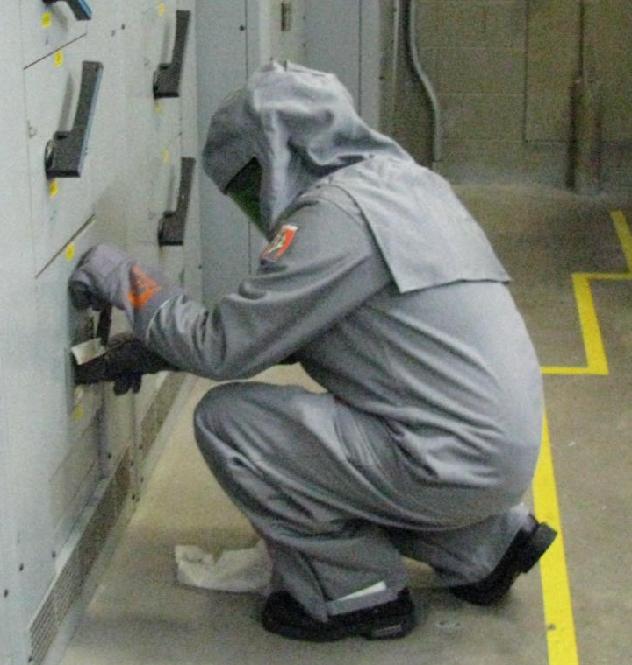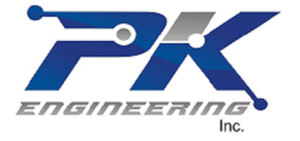How Your Workplace Will Benefit From
Our Arc Flash Studies
We handle everything or just what you need
Our goal is to make your Electrical Safety Program an integral part of your safety culture.

We offer services from a complete turn-key arc flash risk assessment and development of an electrical safety program to an update of an existing study
Qualifications
- The engineer performing the study has 40 years of experience in the electrical field, specializes in performing power systems studies and is a Registered Professional Engineer with the State of Alabama (license number 29640)
PK Engineering’s Turn-key Arc Flash Safety Program
- We come on site and collect data from all necessary electrical equipment likely to be serviced while energized such as:
- utility information, generators, switchgear, protective relays, CT’s, busways, MCCs, cables, transformers, fuses, breakers and motor data.
- Model the electrical system using EasyPower Version 10.3.
- Complete a short circuit study.
- Overcurrent protective devices such as circuit breakers and fuses should interrupt and isolate faults during a short circuit condition safely with minimal equipment damage and minimal disruption to plant operation. These devices plus the other parts of the system including the bus ducts, cables, and disconnect switches shall be designed to withstand the thermal and mechanical stresses resulting from the maximum flow of short circuit current during the fault. It is recommended that the facilities Short Circuit Study be updated every five years and after any major modifications.
- The report includes recommendations for correcting any overdutied electrical equipment.
- Complete an arc flash risk assessment.
- The study will be performed in accordance with NFPA 70E, OSHA 1910 Subpart S, and IEEE 1584 Standards.
- The Arc Flash Risk Assessment will determine:
- The Arc Flash Boundary
- The Limited Approach Boundary
- The Restricted Approach Boundary
- The Arc Flash Incident Energy Level
- The Required Personal Protective Equipment
- Recommendations for Arc Flash and Shock Hazard PPE
- Included in the Arc Flash Risk Assessment Report
- Introduction Section:
- Pertinent data, rationale employed, and assumptions in developing the calculations in the introduction section.
- Executive Summary Section:
- Summary of arc flash incident energy levels.
- Arc Flash Report Section:
- Detailed Summary Spreadsheet
- Arc Fault Bus Name
- Arc Fault Bus kV
- Upstream Trip Device Name
- Upstream Trip Device Function (when applicable)
- Arc Gap (mm)
- Bolted Fault Current
- Arcing Fault Current
- Trip time
- Opening Time
- Arc Time
- Equipment Type
- Arc Flash Boundary
- Working Distance
- Arc Flash Incident Energy
- Detailed Summary Spreadsheet
- Recommendations Section:
- Provide recommendations to reduce arc flash incident energy levels for all equipment rated greater than 1.3 cal/cm2.
- Introduction Section:

- Arc Flash and Shock Hazard Warning Labels
- Come onsite and apply specific-hazard arc flash and shock hazard warning labels on all switchgear, power panels, NEMA distribution panels and other electrical equipment likely to be serviced while energized.
- Items listed on each label:
- Arc Flash Incident Energy Level
- Arc Flash Incident Energy Level Working Distance
- Arc Flash Boundary
- Maximum Short circuit Current
- Required Arc Flash PPE
- Nominal Voltage Level
- Limited Approach Boundary
- Restricted Approach Boundary
- Name of Panel or Equipment
- Company Name Performing the Analysis
- Date

- Protective Device Coordination Study
- An electrical system that is coordinated is one where the protective devices such as fuses and circuit breakers, are carefully chosen so that only the protective devices immediately upstream of the overcurrent fault will open to isolate the fault.
- In an electrical system that is not coordinated, a fault occurring on a particular piece of equipment may not be isolated by the immediate upstream device and open the next upstream device resulting in unnecessary loss of production to equipment not involved in the fault. Additionally, it will require extra time to identify the equipment that caused the original fault.
- Protective Device Coordination Study includes an outline of specific violations of NEC (National Electric Code) and recommendations for correct protective device (fuse and breaker) sizes and settings to properly protect equipment from damage and eliminate unnecessary production downtime.
- Create an electrical system single-line drawing of the facility created in DWG (ACAD) and PDF formats.
- Installation of Arc Flash and Shock Hazard labels.
- Electrical Safety Program Checklist.
- Audit form for use to qualify and document maintenance personnel electrical safety proficiency.
- PPE specification including clothing, gloves, test equipment and tools.
- Onsite Electrical Safe Working Practices Training is customized for your facility, and includes all necessary training required for compliance with OSHA and NFPA 70E-2018.
- Facility specific Electrical Safe Working Practices Booklets are provided for maintenance personnel.
- Awareness training for non-electrical personnel is included.
Frequently asked Questions About Arc Flash Hazard Safety Analysis
We have experience with the implementation of the NFPA 70E Arc Flash Safety Rules since 2001 and have applied our knowledge and experience in managing all aspects of electrical safety to our complete Electrical Safety Turn-key Program.
We provide electrical safe working practices training for both electrical and non-electrical personnel and Electrical Safe Working Practices pocketbooks for electricians containing your facility’s site specific policy that we develop with your input.
Yes. If a serious electrical incident occurred at your facility and you were not following the NFPA 70E guidelines, you would likely be cited for being out of compliance with 1910.335 (a) (1) (i) which requires that employees wear protective equipment where an electrical hazard exists, and 1910.132 (d) (1) which requires the workplace be assessed for hazards and the need for personal protective equipment.
An arcing fault is the flow of current through the air between phase conductors or phase conductors and neutral or ground. An arcing fault can release tremendous amounts of concentrated radiant energy at the point of the arcing in a small fraction of a second resulting in extremely high temperatures, a tremendous pressure blast, and shrapnel hurling at high velocity (in excess of 700 miles per hour).
Arcs can be initiated by a variety of causes, such as when:
- Worker incorrectly thinks the equipment is de-energized and begins to work on it energized.
- Worker drops or improperly uses tools on energized equipment.
- Dust, water or other contamination accumulate and cause insulation breakdown.
- Connections loosen, overheat, reach thermal runaway and fail.
- Current overload
- Voltage transients
Exposure to an arc flash frequently results in a variety of serious injuries and in some cases death. Workers have been injured even though they were ten feet or more away from the arc center. Worker injuries can include damaged hearing, eyesight, and severe burns requiring years of skin grafting and rehabilitation.
Equipment can be destroyed causing extensive downtime and requiring expensive replacement and repair. The cost of treatment for the injured worker can exceed $1,000,000/case. Significant litigation fees, insurance increases, fines, and accident investigation costs can occur. This does not include work in progress loss or job layoffs as a result of the process interruption. These cumulative costs can exceed $10,000,000.
There are four main regulations governing arc flash. They include:
- OSHA Standards 29-CFR, Part 1910. Occupational Safety and Health Standards. 1910 sub part S (electrical) Standard number 1910.333 specifically addresses Standards for Work Practices and references NFPA 70E.
- The National Fire Protection Association (NFPA) Standard 70 "The National Electrical Code" (NEC) contains requirements for warning labels.
- NFPA 70E provides guidance on implementing appropriate work practices that are required to safeguard workers from injury while working on or near exposed electrical conductors or circuit parts that could become energized.
- The Institute of Electronics and Electrical Engineers (IEEE) 1584 Guide to Performing Arc-Flash Hazard Calculations
OSHA is an enforcer of safety practices in the workplace. OSHA 1910.132(d), and 1926.28(a) states that the employer is responsible to assess the hazards in the work place, select, have, and use the correct PPE, and document the assessment. Though OSHA does not, per se, enforce the NFPA 70E standard, OSHA considers the NFPA standard a recognized industry practice and the administration's field inspectors carry with them a copy of the NFPA 70E and use it to enforce safety procedures related to arc flash.
The employer is required to conduct hazard assessment in accordance with 29CFR1910.132(d)(1). Employers who conduct the hazard/risk assessment and select and require their employees to use PPE, as stated in the NFPA 70E standard, are deemed in compliance with the Hazard Assessment and Equipment Selection OSHA Standard.
Electrical inspectors across the country are now enforcing the new labeling requirements set forth in the 2002 National Electric Code (NEC).
In order to select the proper PPE, incident energy must be known at every point where workers may be required to perform work on energized equipment. These calcuations need to be performed by a qualified person such as an electrical engineer. All parts of the body that may be exposed to the arc flash need to be covered by the appropriate type and quality of PPE. Proper PPE can include: Flame resistant clothing, hardhat, hood, face shield, safety glasses, gloves, shoes, etc. depending upon the magnitude of the arc energy.
Please feel free to contact us with any questions. We are always happy to answer questions and provide advice free of charge!
Our #1 goal is to help save lives and avoid devastating injuries. Make sure your employees are provided with proper electrical safety training and gear.
Call us at (205) 457-2526 today!
